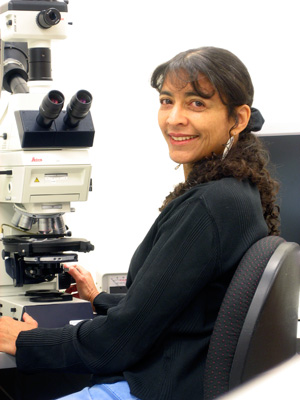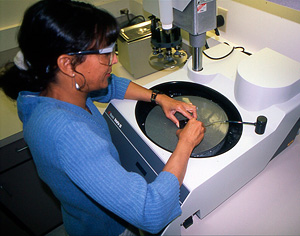 PaleoPeople
PaleoPeople
Karen Chin
University of Colorado, Boulder, CO, USA
— Interview conducted August, 2010
Dr. Karen Chin is an Associate Professor in the Department of Geological Sciences at the University of Colorado and Curator of Paleontology at the University's Museum of Natural History. Her major area of interest is Mesozoic paleoecology, but she may well be better known as one of the leading experts on coprolites (fossilized feces). Dr. Chin's studies of coprolites have added much to our understanding of the paleobiology of dinosaurs and other vertebrates. She received her Ph.D. in Geological Sciences from UC Santa Barbara in 1996. |
 Karen Chin loves working at her microscope almost as much as being in the field. Photo courtesy of Karen Chin. |
A: I was always interested in science, but when I was young, I only wanted to learn about live organisms. Then I got a job working with Jack Horner at the Museum of the Rockies and found out how intriguing fossils are. At the time, I was a graduate student at Montana State studying modern grasslands — not dinosaurs.
Q: Would you explain what your main research is about?
A: I work to try to reconstruct ancient ecosystems, particularly Mesozoic paleocommunities. One of the main tools I use to do this is to examine fossilized feces — coprolites. Coprolites give us different perspectives on ancient life. They complement what we learn from skeletal fossils and provide insights on interactions among ancient organisms.
Q: How would you describe a typical day for you?
A: My days are very full; I work with students, teach classes, do research, oversee the care and organization of our trace fossil and fossil eggshell collections, and go to many meetings!
Q: What subjects do you teach?
A: Paleobiology, Evolution of Life: the Fossil Record, and a graduate seminar on Paleoenvironmental Evidence. I also plan to teach a course on science and the media in the near future.
Q: Evolution of life … evolution has certainly been in the news a great deal lately, particularly with the media coverage of the Dover, Pennsylvania, school board's attempt to have "intelligent design" taught in science classes. Have you had students upset that you teach about evolution?
A: None of my students have openly questioned evolution. They have more problems trying to get a handle on the depth of geologic time. This is not surprising. The magnitude of geologic time is really incomprehensible — even to those of us who study the ancient world.
Q: You mentioned your research earlier. People may have seen pictures of you working at a microscope. Do you do fieldwork, as well as lab work?
A: Yes. I have worked in Montana, New Mexico, Utah, Colorado, the Canadian Arctic … I love field work! But every hour of field work leads to many hours of work at my computer and in my lab.
 Karen Chin makes thin sections of coprolites to examine dietary residues from ancient organisms. Photo courtesy of Karen Chin. |
A: I would probably say that one of my most exciting research experiences occurred when I examined a tyrannosaurid coprolite from Canada. I noticed some structures in the sample that appeared to be fossilized muscle tissue. I was very excited! It just didn't seem possible that this soft tissue passed was fossilized in the feces after digestion, but further analyses backed up my initial hunch. [Note: The results of Dr. Chin's research on this coprolite were published in the professional journal Palaios in 2003]
Q: Have you studied coprolites from any animals other than dinosaurs?
A: Yes. Dinosaur coprolites are actually rather rare. Coprolites from fish and other aquatic organisms are much more common. Some recent coprolites I've studied are from Late Cretaceous marine rocks from the Canadian Arctic. These were probably produced by fish and marine reptiles.
Q: What did you find in these coprolites?
A: Some contain zillions of tiny planktonic organisms, and others include the remains of marine invertebrates like clams and lobsters.
Q: One last question. What do you see as the future direction for paleontology?
A: Learning about ancient ecosystems and environments is relevant as we face climate changes that we are responsible for. Paleoecological studies help us understand how changeable the Earth and its inhabitants are.